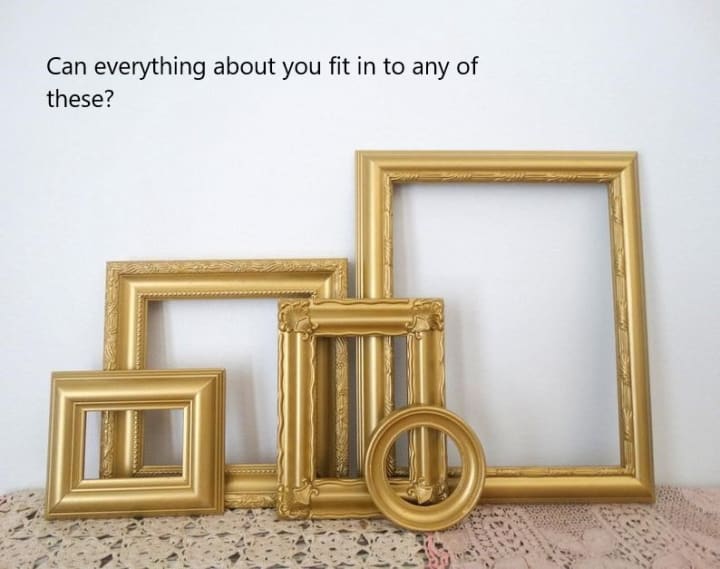Colour Un-coded
How a black man defines ‘black’ to a man who cannot physically see black.

Thinking of the impossible, try teaching the meaning of a colour to someone who, physically, cannot see that colour. It isn’t about squinting or lighting or distance. How can you describe the meaning of a colour to someone who can only see green for everyone’s skin colour?
As you might have read from another article I wrote on Vocal, I have some funky stuff going on at the back of my eyeballs (colour deficient), but to be frank, I focus on the funky stuff happening around me.
To set the scene for my initial question, let me tell you about a real example from one of my it-happened-at-the-office experiences as a post-secondary student on a work-term. The two groups I was helping encompassed about 40 scientists and we generally got along great and everyone was very respectful. (There was one odd ball in this regard, but this story is not about him.)
One of them, was of a certain height, walked a certain way, pursed her lips in a certain way when her mouth was closed, was somewhat soft-spoken, precise…well, to avoid the risk of making her self-conscious, let’s just say I was pretty convinced she had a Japanese ancestry in spite of growing up here in North America. So, I never shook her hand, always used both hands to give her paperwork, and would give a very slight bow at the end of conversations with her. I figured that was culturally appropriate.
A few weeks in and one of her colleagues (at a nearby desk) and I got to chatting and he was curious about my bows, so I told him. He laughed - and will probably still chuckle a little bit upon thinking back - and told me she was black. It wasn’t long before she found out and she chuckled, probably not knowing what to think.
Don’t get me wrong, it was great growing up in the twentieth century having the humanitarian superpower of being immune to the disease of racism since it was physically impossible for me to be racist (due to my eyes). Now, that is not enough.
Have I ever tried to fix this? Yes. Once. Recently.
There is one company in the entire world that manufactures glasses that look like sunglasses, but enable me (and many other colour-deficients) to see a wide variety of colours (outside of the usual three), assuming there is lots of ambient light. Yup, I got to see how blue the sky really is and the difference between a tree trunk and a red brick building for the first time in my mid-30s.
In the six weeks prior to their delivery (imagine how backlogged that one company is), I got to thinking about what seeing colours would actually be like. One of the questions I faced was whether or not I wanted to see the basis for racism. That, I always found absurd since we are all just shades of green to me and I didn’t know if I wanted to see that. It took several days of thinking about it rather intensely before I decided to accept wearing them. (I even posted a self-interview video on my thoughts on all this, although you will have to crank up the volume.)
Why did I choose to accept wearing the glasses that were still on their way to me? Two reasons. One, I get to take off the glasses and still be me, someone who, primarily, cannot be racist because I cannot detect what is required to be a racist. Two, I have enough wherewithal to experience the good side of colour when I wear those glasses.
Okay. What is ‘black’?
I’m not going to get into identifying all my coping mechanisms here. Those only leave me with guessing at cues others say I should pay attention to and then impressing upon myself (like you would when cramming for an exam) the association of certain expectations and considerations whenever I encounter those cues. Instead, I am asking you for a description of a skin color I can grasp. If you are black, you are exempt. I already found someone who pretty much tells me every time I meet him - and I don’t mind. Let me tell you how he does it.
To begin with, Raïmi's general appearance is a neat, subtle, happiness. It’s kind of like bubbles in a fizzy drink. If you watch for more than a few seconds, the bubbles rise up and pop delightfully. If you see him walking down a hallway, he may suddenly twirl and do a small happy-dance move. (Note, that’s only one example of how this can manifest and was expressed in a way congruent with his personality. )
Whenever Raïmi speaks, it always comes from a fulsome place that seems to uplift his spirit, even if something has gotten under his skin. Even if he had had a stutter, it is clear to me those words smooth over something deep inside making it seem like the simple act of speaking empowers, even if it has nothing to do with diversity and inclusion. Energy like that is poignantly passionate and it’s the type you can ignore only briefly and only if you try really hard to suppress it.
That’s my definition of a person who is black. Any nuances or additions to that, I consider individual personality. I mean, I have encountered people who are negative versions of that; but then there are negatives for all adjectives (for example ‘white’ and ‘white trash’). Plus, you have to remember the there are black people all over the world and even though I cannot see them, I know they are there! What I am saying is, you can also add the dimensions of national and cultural personalities on top of all this to boot.
To sum up why this approach to defining a skin colour makes perfect sense to me, an indigenous elder put it best in a talk where he contrasted ‘defining identity’ with ‘identifying’. The former term is about being stuck in the past by defining oneself according to an image that may no longer hold true by anyone’s account. Identifying, however, focuses on the process of the way you choose to identify in the present - not every five seconds, but in a contemporary context, at least. An over-simplified example of this would involve you NOT being a deerskin-covered person skipping around a large fire, but instead being a person in the twenty-first century who lives in a such a way that you listen and care about what the land might have to say. You can see much more about people when they are not stuck in a picture frame.

That works out well since the guy who defined black for me wouldn’t fit in a frame.
So…what does Raïmi do? Quite a bit, I would say and he is excited about the work done at the organisation where we both work. My conversations with him became longer than a minute or so after I took part in a roundtable about diversity and inclusion in the workplace presented in front of an entire division within the organisation. Topic representatives included mental health, immigration, medical conditions, religious tolerance, gender equity, and disabilities (that was me). Finding all these perspectives really interesting, I continued with several small group discussions in the many weeks that followed, which is when he and I got to talking much more.
With that, I was left with one concern. If you identify with something I cannot see right off the bat, how can neither of us miss out and neither of us offend the other? I would like to not miss out on a part of you that you consider very important, from the very beginning of our relationship. Equally, I do not want to silence you because you cannot berate me for not seeing an aspect of you that you likely consider important. In short, I wish for no discomfort or insult there in either of us.
What I find inspiring about the man who inadvertently helped me define ‘black’ as a skin colour, is the fact that I could not have finished this article without resolving that concern.

Just skip straight to sharing perspectives. No more bandaid assumptions or hoping that coping mechanisms will provide the info before it is needed for a specific person. I resolve to approach every single human being in a way that starts with recognition that neither of us knows what the other knows and to have that fact reign supreme from the start.
To Raïmi, the man who taught me the meaning of ‘black’, thank you for unknowingly espousing an incredible, living example that sparked this reflection. It seems like I did not need those glasses (which I have not worn in quite some time) to see humanity’s true colours.
While this approach may work for black, yellow, red, white, blue, or olive skin colours, I am now wondering about applying the same approach to other aspects of identifying. While I have zero problem with anybody identifying in a positive way in any regard, now I will make sure I can see your true colour when you do!
About the Creator
Richard Soulliere
Bursting with ideas, honing them to peek your interest.
Enjoyes blending non-fiction into whatever I am writing.






Comments
There are no comments for this story
Be the first to respond and start the conversation.